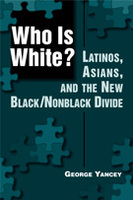Naked Bodies, Bodies of HistoryPosted in Articles, Arts, Asian Diaspora, Literary/Artistic Criticism, Media Archive, United States on 2013-07-01 02:12Z by Steven |
Naked Bodies, Bodies of History
Hyphen Magazine: Asian America Unabridged
2013-06-27
“She mimics the speaking. That might resemble speech. (Anything at all.) Bared noise, groan, bits torn from words…From the back of her neck she releases her shoulders free. She swallows once more.”
So begins the story of the halting diseuse, or female storyteller, of Theresa Hak Kyung Cha’s genre-defying text Dictée, first published just over three decades ago in 1982. Organized in nine parts named after the Greek Muses, Dictée has been described in mythic terms – a Korean Odyssey, a rewriting of the Hesiodic Catalogue of Women, a theatrical ritual, a shamanistic exorcism. Above all, however, Cha’s work interrogates history, refracting the history of Korea in the twentieth century through the themes of exile, the displacement of colonized bodies, and the lost – and resurrected – bodies and voices of women…
…I must have had Dictée on the brain, because I thought of Cha’s work again a few weeks ago when I dropped by the DePaul Art Museum to see the exhibit War Baby/Love Child: Mixed Race Asian American Art, curated by DePaul and San Francisco State University professors Laura Kina and Wei Ming Dariotis. The exhibit is part of a larger project that features visual media produced by nineteen artists who hail from the rapidly expanding community of 2.6 million Americans (and counting) who identify as Asian American plus one or more ethno-racial groups. While the exhibit blurb explains that the show “examines the construction of mixed heritage Asian American identity in the United States,” this actually doesn’t do justice to its ambitious range, which not only investigates the historical origins of these identities (U.S. wars in Asia, colonialism, transnational adoption, the 1967 Supreme Court decision Loving v. Virginia outlawing laws against interracial marriage) but breaks down insidious present-day theories about “post-racialness,” while also featuring work by a younger generation of artists who seem to stay out of the conversation completely.
In an interview, Dariotis revealed that the title of the exhibit was inspired by her own experience fielding annoying questions about her background (which, incidentally, is Chinese, Greek, Swedish, English, Scottish, German, and Dutch). According to Dariotis, people would inquire whether her parents “met in the war.” “And I always ask myself, ha, I was born in 1969, we were not at war with China in 1969. Where did they get this image?” Dariotis’s story highlights persistent mainstream assumptions about mixed-race (if not mixed-ethnic) Asian Americans of a certain age as either/or – that is, either the product of military personnel and Asian women, or free-love hippies indulging in illegal interracial sex. If Young Jean Lee’s Untitled Feminist Show offers a critique of the sexualizing of women’s bodies, War Baby/Love Child draws attention to the cultural sexualization of specifically Asian (and mostly female) bodies through the bodies of their mixed-race offspring…
Read the entire article here.


